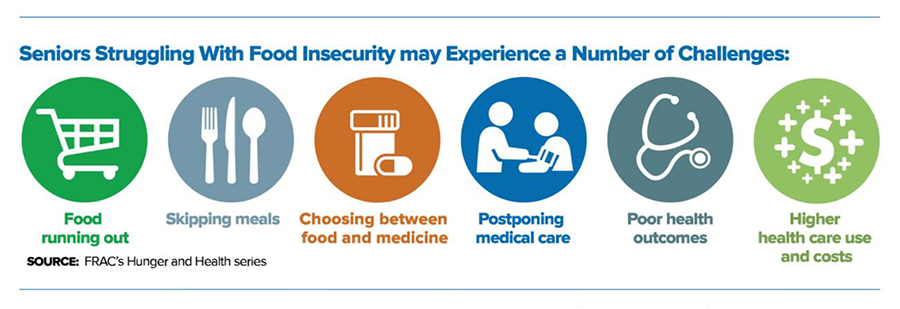May is Older Americans Month and this year’s theme is Communities of Strength. One way ASA members can help build strength in their communities is by redoubling efforts to address the unprecedented rates of food hardship among older adults fueled by the COVID-19 health and economic crisis.
Ensuring older adults have access to nutritious food is always paramount but has become even more so during COVID-19, which has increased risk for older adult malnutrition. In the past seven days, some 2 million older adults ages 65 and older reported that their household sometimes or often didn’t have enough to eat, according to Household Pulse Survey data collected from March 17-29, 2021. That’s 4.3 percent of older adults in the United States.
Longstanding racism and discrimination continue to exacerbate who is hungry in America. Inequities are displayed in hunger rates that are higher for Black, Latinx, American Indian, Alaska Native, Native Hawaiian, and Pacific Islander older adults.
Hunger is a health issue.

Food insecurity has serious consequences for the health and well-being of older adults and their families. But beyond those consequences, food insecurity also has costly implications for the healthcare system. The attendant harms of food insecurity as well as diet-related chronic disease have propelled the United States Department of Agriculture (USDA) to adopt a range of actions to strengthen and improve the reach of the federal nutrition programs during COVID-19.
SNAP: A Highly Effective Tool for Addressing Hunger Among Older Adults
Fortunately, solutions exist to support nutrition for older adults, including increased use of the Supplemental Nutrition Assistance Program (SNAP). By providing monthly benefits to eligible low-income people to purchase food, SNAP plays a critical role in reducing hunger, malnutrition and poverty. SNAP can reach any eligible older adult with a benefit that is 100 percent federally funded.
While SNAP is available to individuals of all ages, the program is well-suited to benefit older adults:
- SNAP protects older adult health and helps maintain independence.
- SNAP can be used at tens of thousands of locations across the nation where older adults would normally purchase their food.
- SNAP boosts the income of older adults.
Take Three Actions this Month to Address Hunger Among Older Adults
- Spread the word about the importance of SNAP and other nutrition programs for older adults: The USDA and the U.S. Department of Health and Human Services (HHS) administer a number of federally funded nutrition programs that support the food and nutritional needs of older adults who are low-income. USDA programs include SNAP, the Commodity Supplemental Food Program and the Child and Adult Care Food Program. HHS programs include the Home-Delivered and the Congregate Meal programs. Use this Food Research & Action Center (FRAC) older adult nutrition program fact sheet to spread the word.
- Lift up how older adults all over the country benefit from SNAP: SNAP is the only nutrition program available to all eligible older adults in every part of the country. Nationally, in fiscal year 2019, SNAP reached on average each month 5.3 million low-income households with individuals ages 60 or older (according to the most recent data available), and this number has grown during COVID-19. In every county of our nation, whether metropolitan, small town or rural counties, SNAP matters to older adults.

Use this FRAC tool, supported by the AARP Foundation, to see how many older adult households in each county benefit from SNAP.
- Connect more older adults to SNAP by sharing information on how SNAP is responding to help older adults during COVID-19: Even though SNAP helps millions of older adults improve their nutrition, health and well-being, millions more are eligible and not participating. In Fiscal Year 2018, SNAP only reached 48 percent of eligible older adults. Older adults have shared that they do not participate in SNAP in part because of the perception that they will only get the minimum benefit of $16 per month, or that the application process is too complicated. Now is an opportune time to connect older adults to SNAP, in part because the amount of SNAP benefits a person receives has been increased and the application and re-certification process has been streamlined in response to the COVID-19 hunger crisis. Learn more about SNAP policy changes.
Pledging to increase access to and strengthen SNAP and other nutrition programs is an important way to improve the nutrition, health and well-being of older adults, and also to strengthen our communities and recognize Older Americans Month.
For more on addressing hunger, sign up for the FRAC Action Network.
Alexandra Ashbrook is director, Special Projects & Initiatives at the Food Research & Action Center in Washington, DC.













